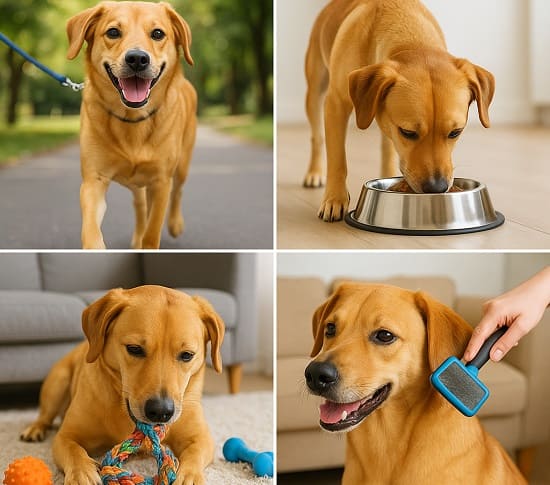Bringing a dog into your home is a life-changing experience, filled with wagging tails, unconditional love, and plenty of slobbery kisses. But for new dog owners, it’s also a commitment that comes with responsibility. Understanding the basics of dog care is crucial for ensuring your furry friend lives a happy, healthy, and fulfilling life. Here’s a comprehensive guide that covers everything you need to know.
1. Choosing the Right Dog for Your Lifestyle
Before even bringing a dog home, it’s important to choose a breed (or mix) that suits your lifestyle. Are you an active person who loves the outdoors? Breeds like Labrador Retrievers or Border Collies might be a good fit. Prefer a calm companion for apartment living? A French Bulldog or Cavalier King Charles Spaniel could be perfect. Consider size, energy levels, grooming needs, and temperament.
2. Preparing Your Home
Just like baby-proofing a house, dog-proofing is essential. Remove hazards such as loose wires, toxic plants, and choking hazards. Set up a designated sleeping and feeding area. Invest in essentials such as:
- A sturdy leash and collar
- Food and water bowls
- A comfortable bed
- Chew toys
- Puppy pads (for training)
3. Nutrition: Feeding Your Dog Right
A balanced diet is the foundation of your dog’s health. Puppies, adults, and senior dogs have different nutritional needs. High-quality commercial dog food usually covers all necessary nutrients, but consult your vet for breed-specific advice.
Quick tips:
- Feed your dog at the same time each day
- Avoid human food (especially chocolate, onions, and grapes)
- Provide constant access to clean water
- Monitor weight and adjust portions as needed
4. Routine Veterinary Care
One of the most important aspects of dog ownership is regular vet visits. Puppies need a series of vaccinations, while adults benefit from annual checkups.
Essential vet care includes:
- Vaccinations (rabies, parvo, distemper)
- Spaying/neutering
- Flea, tick, and worm prevention
- Dental care
- Microchipping
Establishing a relationship with a trustworthy veterinarian early on will give you peace of mind and keep your pet healthy long-term.
5. Training and Socialization
Training is not just about teaching commands—it’s about building communication between you and your dog. Start with basic commands like “sit,” “stay,” and “come.” Use positive reinforcement (treats, praise) instead of punishment.
Socialization is just as vital. Expose your pup to different people, dogs, sounds, and environments during the first few months. A well-socialized dog is less likely to develop fear-based behaviors.
6. Exercise and Mental Stimulation
Dogs need both physical and mental exercise. The amount varies by breed, but even low-energy dogs need daily walks. Playtime, fetch, puzzle toys, and basic agility training can keep your dog sharp and prevent boredom-related behaviors like chewing and digging.
Tip: A tired dog is a well-behaved dog.
7. Grooming Essentials
Grooming isn’t just about looks—it’s about health too. Depending on the breed, your dog may need daily brushing or occasional trims.
Routine grooming checklist:
- Brushing (daily to weekly)
- Bathing (once a month or as needed)
- Nail trimming (every 3–4 weeks)
- Ear cleaning
- Dental care (brushing and dental chews)
- Start grooming routines early so your dog gets used to being handled.
8. Understanding Canine Body Language
Dogs communicate largely through body language. Learning to interpret their signals can help you build a stronger bond.
- Wagging tail: usually happy, but can also mean excitement or anxiety
- Ears back: fear or submission
- Growling or showing teeth: a warning
- Tail tucked between legs: fear or nervousness
- Respect your dog’s signals, and never force interactions when they seem uncomfortable.
9. Building a Bond and Routine
Dogs thrive on routine. Feeding, walks, playtime, and sleep should all happen at consistent times. Beyond routine, spending quality time—whether it’s cuddling on the couch or exploring a trail—strengthens your emotional connection.
10. Financial Commitment
Dog ownership involves expenses. Be prepared for:
- Food and supplies
- Vet bills
- Grooming
- Training classes
- Emergency costs
Consider pet insurance to help manage unexpected medical expenses.
Conclusion: A Lifelong Commitment
Adopting a dog is more than a decision—it’s a promise. You’re bringing a loyal companion into your life who will depend on you for everything. The rewards are immense, but so are the responsibilities. With the right knowledge, preparation, and heart, you’ll give your dog the happy, healthy life they deserve—and receive unconditional love in return.



